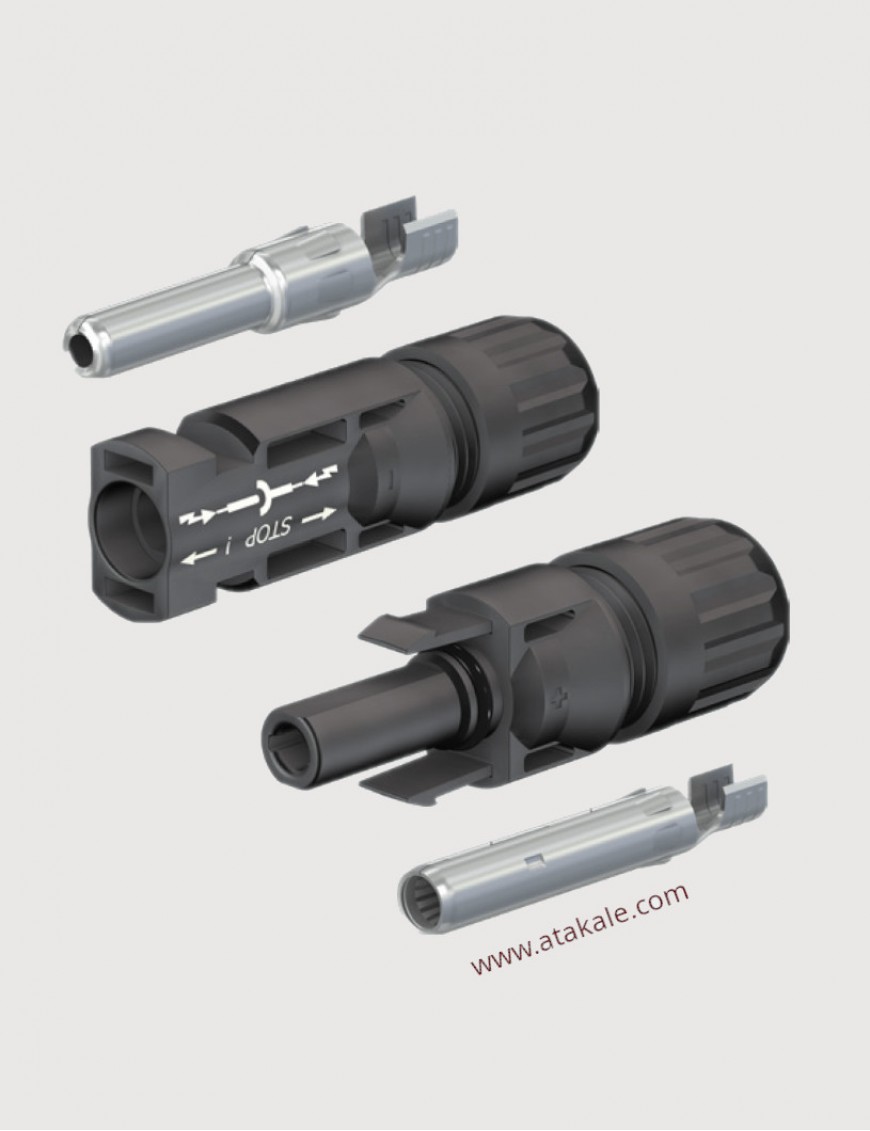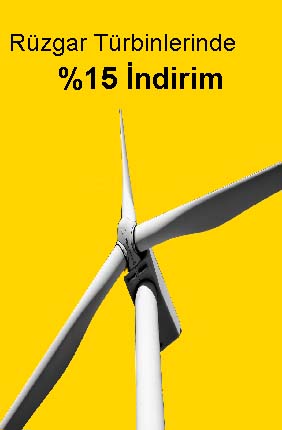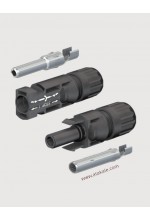Profesyonel Proje Ürün Gurubudur. Ürün sipariş edildiğinde sizin için 7 gün içinde üreticiden /ithalatçıdan tedarik edilerek özel sipariş olarak gönderilecektir. Aceleniz var ise lütfen iletişme geçerek stok öğrendikten sonra satın alınız. Son Kullanıcı Tüketici Elektronik Ürünü Değildir. Satın Alma Şartları , değişim , iade ve garanti şartları tüketici korunma haklarınını içermez. Ticaret Kanunu hükümleri geçerlidir. Sadece bayi ve tüccarlara satış yapılmaktadır. Satın alan kişi bu ürünü kullanmaya yeterli bilgisi ve eğitimi yok ise almamasını tavsiye ediyoruz.
Custom ,Gümrük Tarife GTIP Number:8536690000
10 mm² kablolarla kullanılabilir. PV-KBT4/10II-UR(Dişi -Artı-Mc4) 32.0034P0001-UR + PV-KST4/10II-UR/ 32.0035P0001-UR (Erkek Eksi MC4) Set halinde erkek ve dişi
Orijinal MC4, 20 yılı aşkın bir süre önce şirket içi Satubli uzmanları tarafından tasarlanıp geliştirilen dünyanın önde gelen solar panel MC4 konnektörüdür. Dünya çapında en çok monte edilen PV konnektörü olan MC4'ün patent haklarını elinde bulundurmaktadır, mükemmellik ve yenilik tutkumuz sayesinde yeni endüstri ölçütleri belirlemeye devam ediyor.
Stäubli konnektörleri İsviçre hassasiyetiyle üretilerek küçük ve büyük ölçekli PV sistemleri için optimum verimlilik ve uzun vadeli performans sunar. Konektörleri seçerken, operasyonlarınızın güvenli olacağından ve onlarca yıl boyunca sürdürülebilir bir şekilde performans göstereceğinden emin olmak için orijinaline güvenenlerin tercihidir.
PV projeleriniz için Stäubli'nin üstün kaliteli MC4 solar konnektörünü seçerek, başarı için sağlam bir temel oluştururken riskleri en aza indirir ve verimlilik ve karlılığı garantilersiniz.
PV konnektörlerinin sürekli düşük kontak direnci, verimli çalışma ve güvenli enerji beslemesi için anahtardır. Temas direncinin arttırılması, e. G. Yetersiz malzeme özellikleri nedeniyle tüm PV sisteminin verimliliğini zayıflatabilir
Stäubli PV konnektörlerinin temeli yenilikçi MULTILAM kontak teknolojisidir. Bu benzersiz temas prensibi, sabit yay basıncı ve benzersiz tasarımı sayesinde bağlantı kalitesini ve enerji transferini artıran çoklu temas noktalarıyla öne çıkıyor. Bu, sürekli olarak düşük temas direnci ile iletkenlik demektir, güvenli ve uzun ömürlü bir çalışma sağlar ve arıza süresini ve servis maliyetini önemli ölçüde azaltır.
Bu farklılaştırıcı iletişim teknolojisi, büyük yeniden tamirat maliyetlerine yol açabilecek güç kaybı, kesintiler, sıcak noktalar ve hatta yangın risklerini en aza indirir. MC4 konnektör portföyünün orijinal Stäubli PV konnektörleri sıcaklık açısından oldukça dayanıklıdır ve ısı birikimi göstermez.
Aşağıdaki bilgiler olası kablo tiplerini açıklamaktadır konnektörlerin alçak gerilim DC'de kullanılabileceği yer kablo bükümü, çap aralığı vesıcaklıkları sınırlıyor. Ayrıca, mevcut derecelendirmeler ortam sıcaklığına göre (değer kaybı diyagramları) verilmiştir. Ürünlerin montaj talimatları (yukarıda listelendiği gibi) aşağıdakiler için geçerlidir:PV olmayan kablolar da dikkate alınmalıdır ve bunlara uyulmalıdır.
Genel alçak gerilim DC uygulamaları için ürünler gereksinimlerini karşılar IEC 61984:2008 (Konektörler – Güvenlik) gereklilikleri gereksinimler ve testler).
Ayrıca konnektörlerin teknik performansı TÜV' sertifikalıdır.
IEC 62852:2014 (Fotovoltaik sistemlerde DC uygulaması için konnektörler - Güvenlik gereklilikleri ve testler). UL'de konektörler UL'ye göre sertifikalıdır
6703:2014 (Fotovoltaikte Kullanıma Yönelik Konektörler Standardı Sistemleri). Bu üst düzey PV sertifikası, IEC 61984:2008, UL 1977'nin genel endüstri seviyesi gereklilikleri ve bilinen genel endüstri seviyesi standartlarının çoğunun ötesindedir
(UL 2237, UL 2238, UL 486A/B, vb.). Bunlar TÜV ve UL Ancak sertifikalar yalnızca ilgili PV kabloları monte edilir. Ayrıca konektörlerdeki UR işareti yalnızca Bölümde açıklandığı şekilde bağlanan sertifikalı PV kabloları için geçerlidir.
montaj talimatları (MA231, MA275, MA273, MA285).
■ Konektörler diğer kablo türleriyle kullanıma uygundur. PV kablolarının tümünü desteklemektedir.
■ Fotovoltaiklerin dışındaki sistemlerde kullanım için, PV'ye özel sertifikasyon geçerlidir
■ MC4 konektörler IEC 61984:2008'e standartlarına uygun çalışır (Konektörler - Güvenlik gereksinimleri ve testler)
GES güvenilirliği – bir güven meselesi Saubli Yatırımcıların güvenini kazandıran markadır ve uzun vadeli başarının ,büyümenin temelini oluşturun
Çapraz Bağlantılar PV sisteminizi optimize etme ve bileşenlerin çapraz bağlanmasından kaynaklanan teknik arızaları önleme konusunda en doğru çözümdür.
Pazar Liderliği Dünya çapında kurulu 2 milyardan fazla PV konektörüyle Stäubli, dünyanın kümülatif PV kapasitesinin %50'sinden fazlasını birbirine bağlıyor
Solar Konnektörlerin Parçaları Nelerdir?
Erkek veya Dişi Konnektör: Solar konnektörler eşleştirilmiş çiftler halinde gelir; bir erkek ve bir dişi. Erkek konnektörde bir çubuk bulunurken dişi konnektörde karşılık gelen bir yuva bulunur.
Kontak Pimleri: Her konektörün (hem erkek hem de dişi) içinde metal bir pim vardır. Bu kontak pimleri genellikle mükemmel elektrik iletkenliği ve korozyon direnci sağlayan kalaylı bakırdan yapılır.
Plastik Muhafaza: Bu, her konektörün dış kısmıdır ve genellikle dayanıklı siyah plastikten yapılır. Muhafaza UV ışığına ve hava koşullarına dayanıklı olmalıdır. Plastik muhafaza, bağlantıların yanlışlıkla kesilmesini önleyen bir kilitleme mekanizmasına sahiptir.
Kablo Rakor Somunu: Bu somun konnektör ile kabloyu birbirine sabitler. Kablonun gerilimini azaltır ve hava koşullarına karşı başka bir dayanıklılık katmanı ekler.
MC4 konnektörler, güneş panellerini bağlamak için yaygın olarak kullanılan tek kontaklı elektrik konnektörleridir. MC4'teki MC, üreticinin Multi-Contact'ını (şimdi Stäubli Elektrik Konnektörleri) ve 4, 4 mm çaplı kontak pinini temsil eder. MC4'ler, bitişik panellerdeki uyumlu konektörlerin elle birbirine itilmesiyle panel dizilerinin kolayca oluşturulmasına olanak tanır, ancak kablolar çekildiğinde yanlışlıkla bağlantının kesilmemesini sağlamak için bunları ayırmak için bir alet gerekir. Ulusal Elektrik Yasası (NEC) ve PV konektörlerine ilişkin UL6703 standardı, çapraz eşleşme tehlikelerini önlemek için konektörlerin aynı tip ve markadan olması gerektiğini belirtir.[1][2] Ek olarak, IEC 62548 'PV Sistemleri için tasarım gereksinimleri', PV konektörlerinin aynı kökenden olmasını gerektirir. Başlangıçta 600V olarak derecelendirilmiş olan MC4 konektörünün daha yeni versiyonları, daha uzun seri dizilerin oluşturulmasına olanak tanıyan 1500V olarak derecelendirilmiştir.
-Sistem Voltajı : 1500 V DC
-Nominal Akım(30 °C) :2.5 mm²/14 AWG: 39 A , 4.0 mm²/12 AWG: 51 A , 6.0 mm²/10 AWG 65 A ,10.0 mm²/8 AWG: 104 A
-Delinme Gerilimi :12 kV
-Çalışma ortam sıcaklık: -40 °C…+85 °C
-Maksimum çalışma sıcaklığı :105 °C
-Kaç defa tak çıkart ömrü vardır :100 plug+unplug
Koruma sınıfı, Konnektör takılı ilen P65
-Takılı değilken:IP2X
-Yüksek gerilim koruma sınıfı/Pollution degree :CATIII/3
-Konnektör bağlı iken iletkenlik direnci: ≤ 0.35 mΩ
-Kilitleme Sınıfı -in/locking type :Safety class II
-Konnektöer Sınıfı ,Patent hakkı :MULTILAM
-Terminal iletken meteryali :kalay kaplı bakır
-Uyarı, yük altında takma çıakrtma yapılmaz PC/PA
-Alev Sınıfı: UL94-V0
MC4 sistemi erkek ve dişi tasarımından oluşur. Erkek ve dişi metal kontakları plastik yalıtkanların içindedir; Fişin metal kontağı, sokete benzeyen silindirik bir yalıtkanın içindedir ve soketin metal kontağı, fiş gibi görünen kare bir probun içindedir. Soketin, fiş konnektörünün ön kısmındaki deliklere yerleştirilmesi için merkezi proba doğru hafifçe bastırılması gereken iki plastik kilitleme tırnağı vardır. İkisi birlikte itildiğinde, parmaklar fiş konektörünün yan tarafındaki bir çentiğe ulaşana kadar deliklerden aşağı doğru kayar ve burada ikisini birbirine kilitlemek için dışarı doğru fırlarlar.
Uygun bir yalıtım için MC4'lerin doğru çapta kabloyla kullanılması gerekir. Kablo normalde çift yalıtımlıdır (yalıtım artı siyah kılıf) ve hem UV'ye hem de yüksek sıcaklığa dayanıklıdır (çoğu kablo, güneş ışığından korunmadan açık havada kullanıldığında bozulur). Konektörler genellikle kıvırma yoluyla bağlanır, ancak lehimleme de mümkündür.
Solar Konnektörlerin Avantajları Nelerdir?
Modern güneş enerjisi konektörleri, eski ve tescilli güneş enerjisi fişleriyle karşılaştırıldığında birçok doğal avantaja sahiptir:
Hava Şartlarına Direnç: Güneş konnektörleri, UV radyasyonu, yağmur ve kar gibi zorlu dış mekan koşullarına yıllarca dayanacak şekilde tasarlanmıştır. Genellikle IP67 veya IP68 su geçirmezlik derecesine sahiptirler, bu da neme ve toza karşı son derece dayanıklı oldukları anlamına gelir. Sisteminiz kaçınılmaz olarak zorlu hava koşullarına maruz kaldığında kendinizi sorunlara açık hale getireceğinizden, suya/toza dayanıklılık açısından IP67 veya IP6*'nın altında derecelendirilen konnektörleri asla kullanmamalısınız.
Emniyet/Güvenlik:Solar konnektörler, kazara bağlantı kopmalarını önleyen güvenli bir kilitleme mekanizmasına sahiptir. Ayrıca konut güneş enerjisi sistemlerinde mevcut olan yüksek DC voltajlarını karşılayacak şekilde tasarlanmıştır. Polarite koruması, güneş konnektörlerinin bir diğer kritik güvenlik özelliğidir. Hem erkek hem de dişi versiyonları olduğundan ters polarite neredeyse imkansızdır, bu da kablolama hatalarından dolayı sistemin zarar görmesi riskini azaltır.
Endüstri standartı:Çoğu modern güneş paneli ve taşınabilir elektrik santrali, evrensel olarak uyumlu güneş konnektörleri kullanır. Standart bir güneş konektörü kullandığınızda, diğer panelleri ve bileşenleri herhangi bir sorun yaşamadan değiştirebilirsiniz. Çoğu güneş paneli üreticisi aynı güneş konnektörlerini kullanıyor ve teknoloji önümüzdeki yıllarda standart olmaya hazırlanıyor.
Solar Konnektör Nasıl ve Ne Zaman Kullanılır?
Güneş konnektörleri en yaygın olarak güneş panellerini seri veya paralel olarak birbirine bağlamak için kullanılır. Bazen güneş panellerini bağlantı kutularına ve diğer güneş bileşenlerine bağlamak için kullanılırlar. Kullanımı kolaydır; kilitleme mekanizmasının klik sesini duyana kadar erkek konnektörü dişi konnektöre takmanız yeterlidir. Güneş enerjisi sistemi üzerinde çalışırken daima gücün kesildiğinden emin olun.
Solar konnektörlerin bağlantısını kesmek için, solar kablo ayırma aletini (veya parmaklarınızı) kullanarak yandaki klipsleri sıkmanız yeterlidir. Güneş panelleri ile çalışırken dikkatli olun ve sisteminiz üzerinde asla yük altındayken çalışmayın.





















